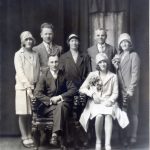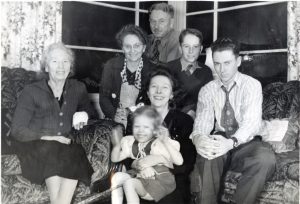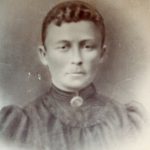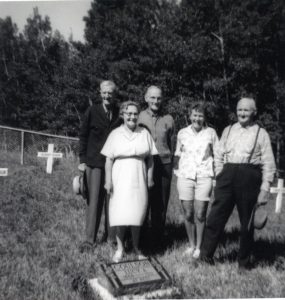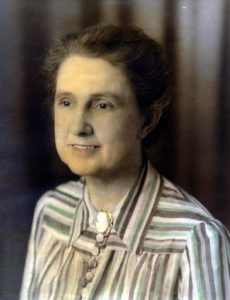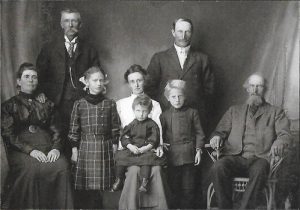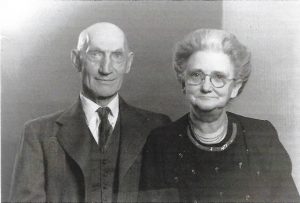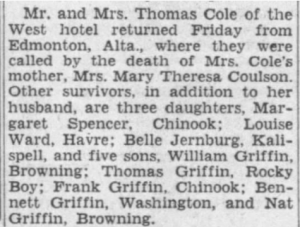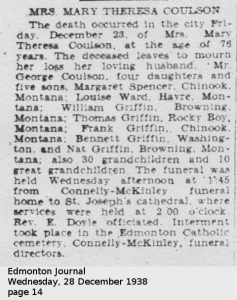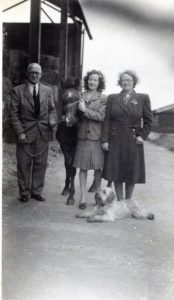In celebration of Mother’s Day, I wanted sum up what I know about each of my great-grandmothers, none of whom I think I ever met in the flesh, although I have gotten to know them a little bit through my genealogical research.
Julia Swedish
“Swedish” wasn’t her real name. The actual spelling, as it appears on her son’s birth certificate, is Swider. This, I believe, is actually Świder, which is the name of a village near Warsaw. But she may not have come from there… according to the family legendarium, she came from the same village as her future husband, which I have determined to be Rozdziele (near Gorlice, about two hundred miles south of Świder), just north of the Slovakian border near the foot of the Carpathian Mountains, in what is now south-west Poland, though when she was born in 1884 it was in the now-defunct Kingdom of Galicia and Lodomeria, part of the Austrian Empire.
According to those family legends, Julia and her future husband emigrated to North America separately in about 1899 and met by chance at a party in New York City, where they got married. Later they moved to southern Alberta’s coal belt and started a dry goods business near Lethbridge through the patronage of a friend. I haven’t been able to back up this story with any documentation, yet. I have found many Galicians in the Ellis Island passenger lists named Swider (and Bubniak, her husband’s name), but no definitive matches.
The earliest firm document I have establishing Julia’s existence is the birth certificate of her first son in 1904. She and her husband were marvelously vague about their past. On the 1906 Canada census (when Julia would have been about 22), it states that she came to Canada in 1900, whereas her husband Joe arrived in 1886 (I am almost certain that Joe’s statement here is bogus, and perhaps hers is too). The 1916 Census states that they both arrived in 1898 (if this is true then she would have been only 14… which might suggest an elopement? But I have no stories hinting at that). And by 1921, they were saying that she arrived in 1903, and he arrived in 1897. So who knows?
Julia’s religion at birth was probably Uniate (Greek Catholic) and her language was probably one of the Western Ukrainian dialects, possibly Lemko. She insisted that her children grow up speaking English, and only her firstborn son spoke any Ukrainian at all. She raised her children in the United Church of Canada, and she was active in the Rebekah Lodge (the female wing of the International Order of Odd Fellows, a fraternal organization with roots in Britain), rising to the rank of “Noble Grand”, the highest post at her local chapter.
Her family’s background was most likely farming, though she helped her husband run the dry goods store from the time of their arrival in Canada until they retired in 1933. At that time they gave the store to their son-in-law (my grandfather) and they moved to a farm in Haney, British Columbia, which is now part of Vancouver’s suburban
sprawl but in those days was quite pastoral. She managed the farm until her husband’s death in 1947, whereupon she moved to New Westminster to live with her son until her death in 1949.
Julia rarely smiled, but here’s a photo of her smiling– this was Christmas 1947 at her daughter’s house, almost a year after her husband died. It was the first time in years when she didn’t have to do all the cooking.
Lucy Scarlett
Lucy Scarlett: What a great name! She was born Lucy Ann Somerfield in 1867 in Bloxwich, Staffordshire, England. The fact that the earliest documents I have for her do not record a father, but show her sharing the same surname as her mother (Jane Somerfield, 1844-1914) leads me to suspect that she might have been born out of wedlock. By the time she was 4 years old, the census of 1871 claims that her mother had married one George Scarlett, a Bloxwich miner, and it appears George has adopted little Lucy, although her name is still “Somerfield”. (In fact, George and Jane did not legally get married until 1873… suggesting a little bit of drama that I have no insight into, except what I read in these old documents).
In 1885 18-year-old Lucy married George Lindley Coulson, a hard-drinking coal miner. He was over 6 feet tall; she was 4 foot 10. The legends say that she was an accomplished singer and even sang “in the opera”. This may be true– there was quite an active music-hall scene in late 19th century Yorkshire, and she may well have taken part.
In 1888 or 1889 Lucy and George departed for America, after first giving birth to two children: Rose (1886-1970) and William, who died in infancy just before they left. They landed in Pittsburgh where she had another son, Tom (1890-1983). In about 1896 they moved out to Wyoming, living in various coal mining camps in the eastern part of the state (mostly Cambria, now a ghost town). There she had five more children: Henry, Mary, Margaret, Fred, and George. Henry, her favorite, died at the age of 4. I can remember Mary, the next daughter, talking about a pearl her mother retrieved from Henry’s clothing… how she would roll it over and over in her hands with a faraway look…
This life was hard on her. Sometime after 1908 her husband decided he had had enough of the United States and wanted to get back to British territory, so the family pulled up stakes again and started heading north-west, mostly on foot, across Wyoming and Montana on a vague, wandering route towards Canada, stopping periodically to work at ranches and coal mines along the way. Lucy had at least one, perhaps two, miscarriages on the trail.
There was no border to speak of in those days, and they finally reached the Northwest Mounted Police outpost of Fort Walsh, Saskatchewan, in August, 1911. Lucy was already suffering from tuberculosis and pneumonia; she died almost immediately from the exhaustion of the journey, and was buried in the police cemetery there. She was only 45 years old.
Lucy was remembered somewhat more fondly by her children than her husband was. Here is a photo of them in the 1960’s when they met at Fort Walsh to install a headstone for her grave.
Robina Woods
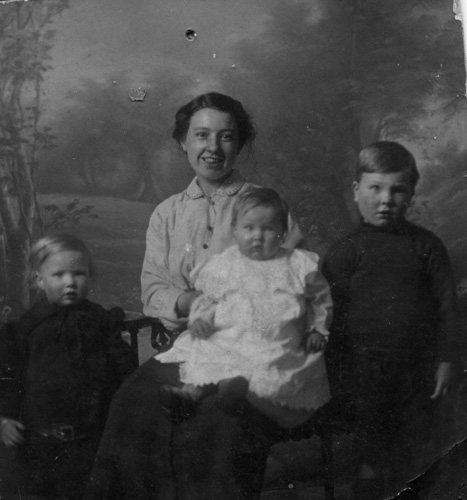
Robina in 1915
Robina Kean Woods was born in a working-class slum in Paisley, Scotland, in 1890. Her father John was a carter, or deliveryman. John’s father was also a carter, and his father had been a boiler stoker at a cloth bleaching factory. Her family on her mother’s side were shoemakers. Both sides came from Ireland, having fled to Scotland some generations previous to escape the Great Famine.
Robina’s family attended the Free Church of Scotland, a fairly radical offshoot of the presbyterian Church of Scotland. She was wrenched into the episcopalian Church of England at the age of 19 when she married William Elliott, a young man who had a good engineering job at the Paisley threadmill. They hid it well, but his family was Irish too, and had left Ireland around the same time as hers and for the same reasons. I mention the Irish connection because in Scotland in those days, to be Irish– even Protestant Scotch-Irish from Ulster– was to be seen as little better than an animal. The Irish were despised and could not aspire to any but the meanest jobs. William’s family had carefully recrafted itself to be seen as Scottish, and William was the first in generations to have any job but unskilled labor. Robina probably thought she was moving up in the world, by marrying him.
They started a family and things seemed to be going well for Robina; her husband’s employer even gave them a nice house to live in in a respectable neighborhood. The First World War changed things, and William’s wartime injuries forced him to seek employment elsewhere. They had to move out of the company house. He became a gamekeeper and had a series of jobs all over the Scottish highlands; Robina, as the gamekeeper’s wife, not only had to keep her own household but also function as a domestic servant at the great estates where they resided.
She had seven children during that time; the family finally emigrated to Canada in 1927. Neither her family nor her husband’s had any background in farming, but suddenly Robina found herself a farmer’s wife in a foreign country with unbelievable temperature extremes and prodigious snowfall. They managed to keep up that life for 9 years, having two more children in that time. Despite all the children they had their differences, and they separated after they retired to Calgary in 1936. Then Robina worked energetically as the manager/caretaker for an apartment building; she outlived William by 14 years and died in 1963.
Cora Foss
Cora was the only child of a farming couple in Ontario. Cora’s family on both sides were solid Upper Canada farming folks. I have been able to trace them back to the American Colonies in the 18th Century, which they probably left as a consequence of the American Revolution; possibly they were part of the Tory exodus to British North America.
Cora herself was born in Norfolk County, Ontario in 1887. She moved with her parents to Olds, Alberta in 1900 when she was about 13, and married John Luska Berkley, a farmer of German descent, in 1904. She had five children. I know little about her except what I have learned from cousins who had contact with her.
She and her husband farmed the same land for 40 years. Their house burned down in the winter of 1935; the community pitched in to help them rebuild. They passed the land on to one of their sons when they retired in 1946; then she lived on in Olds until her death in 1961. She was, I’m told, an excellent seamstress.
Here is a piece commemorating Cora and John’s 34th wedding anniversary that my cousin found in a local newspaper, that gives some flavor of Cora’s household and friends:
OLDS GAZETTE: November 24, 1938: the home of Mr. and Mrs. J. L. Berkley was the scene of a memorable event on Wednesday evening last, when about twenty-five intimate friends and relatives joined with Mr. and Mrs. Berkley in celebrating their 34th wedding anniversary. Preparations had been carried on while Mr. Berkley was away so the whole event was a complete surprise. During the dinner hour (6:30) Mr. Fred Penny proposed a toast to the honored couple, speaking warmly of the friendships which had strengthened during the years. Mr. Berkley replied fittingly.
Neighbors gathered in for the evening to enjoy music and dancing. At midnight when lunch was being served Mr. And Mrs. Berkley with their attendant bridesmaid and groomsman of 34 years ago, Mr. Newt Reid and Mrs. R. M. Anderson, were given the seat of honor facing a five tier wedding cake beautifully lighted with candles. As the other lights were dimmed the Gardin sisters sang very sweetly, “while the Mighty Organ Played.”
The scene was most effective and will live long in the memory of those present. Mr. and Mrs. Berkley were married November 16th, 1904 at the home of the bride’s parents, Mr. and Mrs. A. Foss, when their home was the present Charlie Bowman farm. Rev. Lang was the officiating minister. The day was bright and warm with no signs of snow. Those from a distance attending the anniversary dinner were, Mr. and Mrs. Foss, Olds, Mr. and Mrs. W. Miller, Didsbury, and Mr. and Mrs. W. Golden of Sundre.
(Credit for the above goes to Janis Berkley’s History of the Berkley, Foss, and Connon Families).
Mary Griffin
Mary Theresa Griffin (other surnames are Davis, Paul, Nelson, and Coulson) is someone nobody within my immediate family network even knew existed, until I started my genealogical digging. She’s what you might call my step-great-grandmother. She’s the second wife of George Lindley Coulson, and therefore not in my direct genetic line, but the more I discover about her the more remarkable I find her.
After Lucy Scarlett died at Fort Walsh in 1911 and her (mostly-adult) children scattered to the winds, her husband George wandered back into the U.S.A. and found himself in Havre, Montana in 1915. There he married Mary Griffin, and they proceeded to spend the better part of 25 years together. Who was she?
Mary was Métis, born into the family of Oliver Paul in 1862. She was baptized in St. François Xavier, a village that lies a bit west of the present city of Winnipeg; at that time it was part of a network of communities known as the Red River Settlement, semi-itinerant groups of fur trappers and buffalo hunters in Rupert’s Land, a vast area that had been owned and worked as a monopoly by the Hudson’s Bay Company for two centuries. In a few years title to this land would be transferred to the nascent Canadian government, leading directly to the Red River Rebellion of 1869, followed by the North-West Rebellion of 1885.
Mary fits into this history, somehow, I’m sure. She acquired the surname “Davis” quite early, and in 1879 (when she is just 17) we find her at Fort Assinniboine, Montana. There she met a Scottish immigrant named Jack Griffin who had a government contract hauling firewood to the fort. She became his common-law wife and bore him at least 12 children over the course of 24 years; they finally became formally married in Havre in 1903. Mary, it seems, was Jack’s lover, wife, agent, and manager. She took care of Jack’s ranch, raised his children, and fed his employees. These are details that I have gleaned– perhaps imperfectly– by poring over census records, as well as the birth, death, and marriage records of Mary and Jack’s children.
Jack died in 1913. Mary held an estate sale and sold off all the ranch livestock and equipment. In 1915 she hooked up with my great-grandfather George and in 1917 they moved to Canada. George declared $4,750 in cash and effects to the border officials; I have little doubt that this was Mary’s money. George wasn’t much of a saver.
Mary and George settled in Plamondon, Alberta (near Lac La Biche), and farmed there for almost 25 years, about as long as Mary had been with Jack. I think they chose Plamondon because Mary probably had relatives there: that region had been a welcoming refuge for Métis fleeing the brutal suppression of the Red River fights for independence in 1869 and 1885. I suspect they were not very successful at farming; they probably lived off of Mary’s money and wound up quite poor towards the end. Mary died in 1938 and was buried in Edmonton in an unmarked grave (and George, who died two years later, also has an unmarked pauper’s grave in a municipal cemetery). Mary’s funeral, though, was well attended and some of her children came up from Montana to say farewell.
Violet Clegg
Violet is another step-great-grandmother. She entered my family tree after my grandparents got divorced in 1946, thus introducing a whole new vast network of ancestors to track down.
Violet Elizabeth Clegg was born in a suburb of London in 1886 to a large family– she had four brothers and three sisters. Her father Samuel was in the insurance business, and her mother Elizabeth was “a prominent political and social worker and was also a popular figure on the concert platform” (this from Samuel’s obituary).
In 1909 Violet married a young man named Henry Giles, who may have been an employee or junior associate of her father. After giving her two daughters he went off to the War and was killed in action on the Western Front in 1917. I found it rather fascinating that Violet’s brothers were commissioned officers during the War, but Henry was not. I wonder what, if any, family tension that may have occasioned?
After the War Violet remarried, this time to a charming man named Alfred Willis, who became the perfect father to Violet’s two daughters. They regarded him with great fondness.
After Violet’s daughter married my grandfather following World War Two, I don’t know much about her except a few photos. She looks like a content woman who enjoyed taking vacations with her husband, and I can see she loves dogs. She came over to Canada a few times to visit (I’m told I may have met her, though I don’t remember), and she died in 1971.
You can read more about Violet’s interesting family over on Neil Berrett’s blog.
Conclusion
I like to play the game of how it would be to bring them all together at a Mother’s Day brunch, perhaps. It would have to be prior to 1911 when Lucy died… Let’s say 1910, when Lucy is 44? Julia is 26, Robina is 20, Cora is 23, Mary (the eldest) is 48, and Violet is 24. They were such vastly different women… I wonder how it all plays out.

